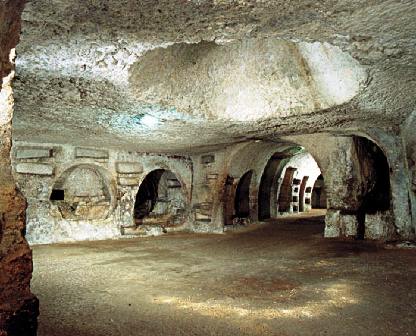Syracuse has the second largest and most important system of catacombs in the world after that of Rome. The only catacombs that currently can be easily visited are the Catacombs of San Giovanni, near the Archaeological Museum Paolo Orsi, an enchanting place where a private association (Kairos) organizes guided tours and in summer also suggestive night tours and night shows. Next to the catacombs you can also admire the unique beauty of the Church of San Giovanni alle Catacombe.
the Catacombs of San Giovanni are of great interest for the rational architecture that distinguishes them. They consist in a huge system of galleries, with thousands of niches, which all come from a main path: a great gallery called the "decumanus maximus", that Christians built by digging and widening a Greek aqueduct, whose traces are visible in the vault. There are innumerable large and small niches on the walls and on the floor.
From the galleries the visitor accesses to wider areas which are circular chapels dedicated to the martyrs. 5 chapels have been discovered to date, and have been called by Eusebius (Pope who died in Syracuse, and who was temporarily buried here), the Chapel of the Seven Virgins, the Chapel of Antiochia, the Chapel of Adelphia and the Anonymous Chapel. In the rotunda of Adelphia, which is among the most significant, was found a sarcophagus of the fourth century with scenes of the old and new testament carved in it, made in honour of Adelphia, wife of Valerius Proculus.
In the main hall, it is remarkable the arched niche entitled to the Virgin Deodata with frescoes representing Christ, the Holy Virgin and the Saints Peter and Paul. Throughout the complex are visible traces of frescoes, while of great interest is the large amount of funerary inscriptions in greek and latin returned from this catacomb complex. The nearby Church of San Giovanni Alle Catacombe still has traces of that charm which urged travelers to visit it during the eighteenth and nineteenth century. For a long time this Church has been identified as an ancient Cathedral of Syracuse, reportedly placed in Akradina, a zone outside the city walls, in the region of the Catacombs, which was the place where, according to tradition, was buried the first bishop of Syracuse, St. Marcian, who was martyred under Gallienus and Valerian (mid-third century). However recent studies have undermined this assumption.
The south facade of the church was destroyed by earthquake in 1693 (it ruined the Great Basilica), so the one visible is that reconstructed in eighteenth century with significant changes to the same facade and to the porch, for the reconstruction of which fifteenth century elements were used.
On the left side we still see instead the ancient Norman façade marked by the rose window and by the decorated portal.
In this place during the classical Greek period there was a Latomia (quarry), while in the Late Hellenistic period there was a pottery laboratory related to pagan worship. In Late-Imperial Christian era it had become a burial area until at least 423 AD. Around the mid-sixth century (perhaps when Pope Vigilius was staying in Syracuse), the burial ground was transformed to create the Crypt of St. Marciano which had to contain the sarcophagus with the relics of the Saint. Therefore, above the crypt was built the Church with an apse, three naves, 12 Doric columns (with reference to the apostles), so that the sarcophagus of the saint was placed and oriented exactly under the first altar, in the center of the nave.
After the ravages of age likely Arabic, the church underwent innovations with the reconstruction of the perimeter walls, the extension with semi-columns of the pillars located in the apse and in the façade, the reduction to 10 of the number of columns and the change of the slope of the floor towards the facade
.In 1428, close to the north wall, a rectangular chapel with a porch was built. In 1630 it was granted to the Carmelites of Montesanto that inserted inside it a new structure differently oriented (North South), which occupied the space of the first two bays of the old structure. The 1693 earthquake caused severe damage repaired in 1705-6, when the porch visible today was rebuilt with reclyded materials.
A staircase leads to the crypt of St. Marcian, where in 61 AD the Apostle Paul preached, and where is located the tomb stone of the Holy Paul, with the small opening through which it was possile to get in touch with the sacred relics. In the center there is an altar surrounded by 4 columns. Under the Normans the central space around the altar was changed with the constructions of 4 pillars which incorporated the old capitals,with the symbols of the Evangelists, and inscriptions taken from the Gospel. In this period a new pavement was put, parts of which are still visible.
The walls have traces of paint, such as in the north side that said “of the two Alexandras”. From the left side of the Church it is possible to access the Catacombs.
Address: Via San Giovanni alle Catacombe 1
Opening hours:
Monday to Sunday (February March November and December Closed on Monday)
From 9.30 to 12.30 and from 14.30 to 17.30 (16.30 from October to March), Ticket Price € 6.00
Guided tour every half hour in Italian or English included.
Under 15 and over 65: € 4.00
Groups and pilgrims: € 4.00
School and religious groups: € 2.00
Free entrance for guides and teachers

